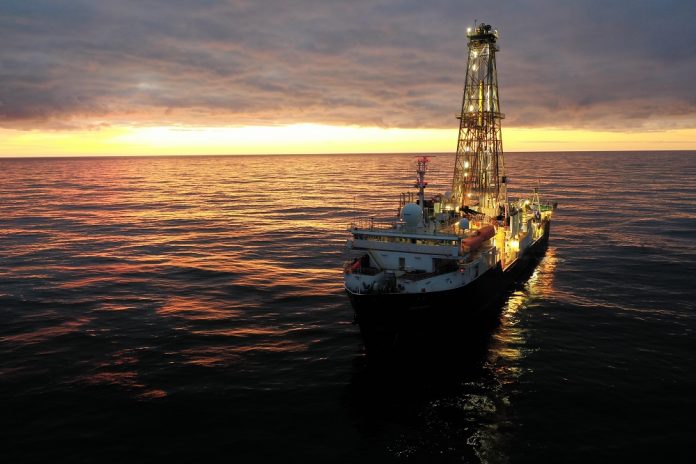The basalts offshore Norway that once likely caused a climate crisis may act as future reservoirs for carbon storage.
Sunrise at Skoll High in the Norwegian Sea. Photo: Peter Betlem
Drilling is currently underway along the mid-Norwegian continental margin as part of International Ocean Discovery Program (IODP) Expedition 396 to explore the links between magmatism and global climate change.
Massive magmatism hit the present-day Norwegian continental margin about 56 million years ago as Europe and Greenland split apart. This was a time period with catastrophic global warming (the so-called Paleocene-Eocene Thermal Maximum or PETM) which was likely triggered by the volcanism.
At that time, up to 6-kilometer-thick basalt sequences were deposited along the incipient continental breakup axis and extensive subsurface igneous layers (called sill intrusions) were emplaced into sedimentary basins closer to the Norwegian mainland.
The sill emplacement caused heating of the host rocks, forming large volumes of greenhouse gases. The release of these gases to the atmosphere likely triggered the PETM.
READ ALSO: Drilling into old lava – Did volcanism cause the hothouse climate? – Daily updates from the ship
IN NORWEGIAN: Borer ned i gammel lava – Daglige oppdateringer fra skipet
Could these very same volcanic sequences now play a role in our efforts to mitigate climate change?
One objective of IODP Expedition 396 is to assess the potential of Norway’s offshore basalts and intra-basalt sequences for permanent mineral storage of CO2.
Carbon capture and storage (CCS) is the process of capturing and storing CO2 through technological means. Most current CCS projects aim to deposit captured CO2 deep underground in sedimentary reservoirs, including depleted petroleum fields. CO2 is typically injected in a supercritical state at high pressures or dissolved in water.
Fluid escape and leakage are major concerns for injection projects where the CO2 remains as a sub-surface fluid thousands of years after injection. After all, if the injected CO2 escapes, it may find its way to the surface and atmosphere where it may contribute as a greenhouse gas.
Pilot studies from Iceland and Washington State in the US show that once CO2 is injected into basalt reservoirs, chemical reactions may turn the greenhouse gas into rock through the formation of carbonate minerals.
The process of turning CO2 into rock is known as mineral carbonation, and effectively stores the CO2 for good. The chemical reactivity of the reservoir rocks is an important factor for successful carbonation, and it may only happen on significant scales if the rocks are sufficiently porous, permeable and reactive.
The on-going drilling of the basalt sequences on the Vøring Margin will help us to assess whether these thick and extensive volcanic sequences may act as future carbon storage reservoirs.
For this aim, we are collecting core data, wireline log data, and petrophysical rock data from several 100-m long basement boreholes. These data will form the basis for years of post-cruise research to investigate the carbon sequestration potential of Norway’s offshore basalts.
Analogue field studies are also underway, and two University of Oslo students, Marija Rosenquist and Max Meakins, have just handed in their Master of Science theses on pilot studies of basalt CO2 sequestration potential of the Faroe Islands.
Porous basalt from beneath the Norwegian Sea.



